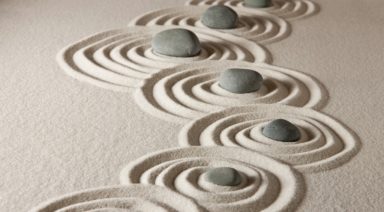How to Create a Meditation Altar

In The Miracle of Mindfulness, Zen Master Thich Nhat Hanh says that we should meditate because “each of us needs to realize total rest…mindfulness is the miracle by which we master and restore ourselves.” Sometimes, even a full night’s sleep doesn’t help you achieve total rest. How can the restless truly rest in modern society? Mindfulness, or the art of living in the present moment, is an important state of being to achieve in such a busy world. It’s not only good for your overall well-being, but it’s also an excellent way to practice self-love. Discover how to make a meditation altar designed for your specific spiritual practice.
1. Develop a Daily Meditation Practice
As we rush through life, many of us feel like we’re not quite present in every moment. According to Karen Kissel Wegela, Ph.D., to counter this feeling, practice mindfulness meditation. Meditation allows you to let go when stressed and accept yourself just as you are – your thoughts, feelings, and emotions as they arise from moment to moment.
It is important to have a meditation practice that grounds and centers you daily. Such a practice will allow you to feel strongly connected to and centered with yourself. Sometimes, breathing exercises aren’t enough. You need a physical place to go to and rest. While mindfulness meditation can be practiced anywhere, having a sacred space to call your own is important. An altar is a beautiful space full of sacred energy that you can tap into when you need it. Anyone can create an inspirational altar with just a few items and pure intention.
2. Stay Mindful When Creating a Home Altar
When creating an altar, start by setting an intention, finding a space, and surrounding your space with things that are sacred to you. It really is that simple.
Visualize the Meditation Space
When setting your intention, utilize your visualization skills and write down what inspires you. Close your eyes, and let the space come to you. What do you see and feel? Even if it seems random, focus on what resonates with you. You may feel pulled to sit on a pillow by a window and let the trees carry away your worries. Write down all that comes to you.
Choose a word for your space. Serenity. Focus. Stillness. Love. Fluidity. It can be a plain or obscure word. What does this word mean to you? Do not look up the definition. Create one. You may choose to take this word and your personal definition and craft an item to display above or on your altar. You could even create your own affirmation or mantra surrounding it.
Give the Space Purpose
What do you want to achieve with this space? Perhaps you want to honor your ancestors and the wisdom they bestow upon you with this altar. Choose one sentence, and let it be your affirmation of intention. Will you use this space to connect to others? Will it be for personal ritual, where you will have tools for specific rites of passage? Will it also be a family altar? This may be your place of solitude where you read or recite mantras. This altar may be a family altar that deepens the bond between you and your loved one.
Make It Practical for You
How often will you use this space? Will it be a place that you come to daily, weekly, or as you need it? Perhaps it will only be used to honor seasonal changes, major life events, or holidays. Also, consider its position within the house. According to the EPA, indoor air can be two to five times as polluted as outdoor air, so if you seek sunshine and fresh air, the basement isn’t your best choice.
How should I furnish my altar? Will a small table suffice, or do you prefer a larger cabinet for storing additional items? Think about the materials and design that resonate with you—wood for warmth, metal for simplicity, or glass for transparency. Consider the height of your altar in relation to your meditation posture and whether you want storage space for meditation cushions, blankets, or other accessories.
3. Your Sacred Space Should Be Peaceful
On your journey to find the perfect sacred space, you’ll likely want somewhere private. It can be indoors in a quiet corner of your bedroom or outdoors under a covered area or spare building. What area of your home do you feel most drawn to and relaxed within? It may be your kitchen, with the warmth of love and the smell of freshly cut herbs. Perhaps it is by your garden. Remember, your sacred space can simply be the corner of a nightstand. It’s about the energy that you’ll cultivate in the space.
The direction of the altar may be important for you to consider, too. Your altar may face East as the sun rises on a new day or a new beginning. The altar may face West as the sun sets into a quiet night, symbolizing solitude and stillness within. The direction of the altar may be aligned with certain elements as well: North representing Earth, East representing Air, West representing Water, or South representing Fire. However, the direction of your altar does not have to be strictly chosen. It’s about what resonates with you and why.
4. Altar Items Should Support and Focus on Intention
Once you’ve envisioned your sacred space, gather items for the altar that reinforce your intention. The key is to include items that hold significant meaning for you. Here are some ideas:
- Candles: Symbolize illumination and spiritual energy.
- Colors: Choose colors that resonate with your intention or have personal meaning.
- Crystals: Precious stones like amethyst are known to sharpen spiritual experiences.
- Essential oil and incense: Use for aromatherapy to enhance relaxation and focus.
- Instruments: Auditory tools like bells, drums, and singing bowls will help ground you.
- Leaves or Flowers: Natural elements to bring the energy of Gaia into your space.
- Mala beads: Made for counting mantras or prayers during meditation, helping focus.
- Meditation pillow: Provide comfort and support while meditating.
- Photos: Pictures of family members, friends, or cherished memories.
- Statues: Representations of animal totems or spirit guides.
As you select each item, ponder its meaning and feel its energy. Consider how it aligns with your intention. Select as few or as many items as you need. Let your intuition guide you as you decorate, allowing your intent to flow into the space and manifest the sacred altar items you desire.
5. Let Your Meditation Altar Change Like You
Nothing is set in stone. Remember to change up your altar. Your intention or mood will adjust. The change might be general or quite specific, depending on what is happening in your life. As you move through cycles of personal growth, your altar will reflect these changes. As loved ones pass, you may choose to mourn or honor them at your sacred space. You may celebrate births and achievements. As you celebrate the holidays or honor the seasons, your altar might reflect each of these occasions.
You may find that your altar does not serve you any longer. In place of something once elaborate, you may decide on something minimalist. Your altar may, in turn, move from a simple walk in the woods to an entire bookshelf or a developed meditation garden.
Days or months may pass where you do not use your altar – and you may even neglect it. You may find that multiple altars spring up throughout your home, even appearing on your desk at work. Who knows? Where you work could be inspired to develop their company altar or meditation room.
How frequently or infrequently you use your altar is not as important as your awareness of your evolving meditation practice, that your altar evolves with it. Follow what resonates. Trust what you know your practice needs. Personal ritual is important to your growth, to mark your rites of passage, and to see where you have been and where you are going. You can’t do that without first looking at where you are. Your altar will witness each of these places with you and it will not judge. No matter if you are crying, angry, or joyous — this place of mindfulness is a placeholder for you to connect with your center, reinforcing your connection to others and the world in the process.
Whatever you choose to do with your altar is valid. Every altar is different and serves many purposes. This is your sacred space. There are no rules, only what you create for the reasons that are sacred to you specifically.
6. Honor Who or What Speaks to You
Honor what speaks to you—whether it’s God, Buddha, Ganesha, or your inner wisdom—and remember to speak back. Your altar is a sacred space that transcends multiple realms of being, connecting the conscious and the subconscious, as well as this plane and higher planes of existence. It serves as a meeting ground of body, mind, and spirit, not just a physical space with a few knick-knacks.
This sacred space is yours to do what you please with, a space to connect with yourself and others. Entire conversations will have taken place within you, and at first, nothing will seem to have changed. You will find that your sense of self becomes more concrete and palpable as you use your altar. Your connection to the Earth will seem to pulsate beneath your feet like blood through veins.
Listen to your instincts and respond. When you do, you are mindfully living in the moment. In turn, your life will resound with the beauty that you see in the smallest or largest of things, as well as the joys and even the sorrows. Listen to yourself, and be just as you are within your sacred space. And when you have trouble sitting still, move with pure love.
5 Ways to Cultivate the Silence Within

Many of us spend our lives searching for inner peace. We look for it in our thoughts, our surroundings, perhaps in the food that we eat, the people who we choose to be with; however, we can’t look for peace outside and assimilate it within us at the same time. We have to create a silence within us for peace to reside, and we have to look at life from the vantage point of this silence. Only then can we be in a state of bliss.
So here are five ways to cultivate the silence within:
1. Spend five minutes every day observing your thoughts. Make an effort during these five minutes to sit in non-judgment. Let your thoughts pass through your mind. Also, make an effort to avoid reliving the emotions brought about by these thoughts, be they positive or negative.
2. Start your day before those in your house do. Even if it’s just fifteen minutes early, spend those first fifteen minutes of the day with yourself. Water your plants. Drink lukewarm lemon and honey water. Stretch. Smile. Read. Making this daily commitment will help you to nurture a more fulfilling relationship with yourself, and this will ensure a better quality day and life.
















